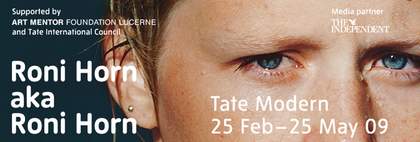The Thames is the first thing I think of in regard to an Encounter piece. The second is the British School painting The Cholmondeley Ladies c.1600–10
I
Around 1998 I was commissioned to do a work involving the Thames. I came over to London and spent a lot of time around the river. The river is mesmerising and I felt deeply drawn to it. At the same time, I had just ended a long love relationship and was extremely sad. So the two things came together in what I now see was a kind of vicarious suicide. This is Still Water (The River Thames, for Example) 1999. It is a series of pictures of the water that are footnoted with whatever I was thinking of at the time, what the river provoked in me and what was in the river itself.
I had this fabulous assistant, Helena Blaker, who helped me to research the river, get some basic facts, and it turned out that the darkness of the river, which I thought was simply mud, etc, was in fact the darkness of London. We were able to interview the river police, taxi drivers, whoever worked on or knew the river, and through them we found out incredible things.* The Thames attracts a very high number of suicides, many from other countries**, and a significant number of so-called deaths by misadventure and death by extremely violent means – lots of dismemberment and so on. More research from Dickens to Conrad revealed that this darkness had historic dimensions as well.
I think of my images of the Thames as a mirror. All the associative images that coalesce around this work, whether it is the similarity of the water with the desert or with aspic***, the endless range of imagery, is a product of photographing something that is a master chameleon. Or the ultimate mime. The ultimate mime is the thing that keeps its distinction from everything else. When you think about that fact – of imitation or reflection and the possibility of losing your identity in that connection – you realise how water never loses its identity, it is always discretely itself.**** And I am deeply drawn to that possibility of existing in two spaces at the same time, without any contradiction; a lot of paradox but no contradiction, a lot of things being the opposite of what they are, but somehow they can carry on with being both sides of the story. The river chameleonised me, as it had done London.***** So this peculiar reciprocity drew me in deeper and deeper. And the footnotes (taken from another water) weave all of this together.
* 505 Here’s a true story. A young actor drowned himself in the river a few years back. He had just been chosen for the part of Edgar Allan Poe in a play based on the life of the writer. Recently he had spoken to the author of the play about dropping the part of Poe and replacing it with a role in which he would play himself. ** 268 Do you remember the young Parisian woman I mentioned earlier? They found a suicide note in her hotel room addressed to her sister. (It was written in French.) The note referred in detail to her problems, including her bad teeth. (She thought they protruded too much.)
269 Police said this surprised them since, in their judgment, she did not have buck teeth. *** 7 The deserts of our future will be deserts of water.
311 This is a gelatinous moment.
312 Concerning “gelatinous or glutinous matters”, see the short story The Facts in the Case of M. Valdemar, by Edgar Allan Poe, 1845.
313 See The Blob, directed by Irwin SYeaworth Jnr in 1958, starring Steve McQueen.
314 See the essay What Is a Thing? by Martin Heidegger, 1967.
315 What does water look like?
316 See aspic. **** Water is transparence derived from the presence of everything.
***** 22 You say it’s a river. I can believe that. But when you say it’s water, I get suspicious.
23 Is the Thames a case of mistaken identity?
24 When you say water,what do you mean?
25 When you say water, are you talking about the weather or yourself?
26 When you see your reflection in water, do you recognise the water in you?
So much for the footnotes. For the photographs I decided to restrict the material to central London. I also wanted the vantage point of a person watching the water from the bank of the river. So we rented a tugboat and built scaffolding on it and fixed the cameras to the scaffolding at angles that would mimic this point of view. We did this in two or three different seasons and were able to get many of the moods of the river.
But then the difficulty was to get a decent shot in what is really a very dark setting, that is in terms of the amount of light. The Thames is a tidal river, moving very quickly, so the water is very dangerous. If you jump in, there is a good chance that you won’t get out. It is not like the Seine. I think of it as wilderness. It is a wild, dangerous place in this urban area. But at the same time the wildness is muffled or masked by a more traditional sense of water - that picturesque or pastoral quality, something you are drawn to…
Water in general seems to occur a lot in my work.

Roni Horn
From To Place – Verne’s Journey 1995
56 pages, 8 duotone, 19 colour reproductions, clothbound
26.5 x 21.5 cm
Courtesy Hauser & Wirth Zürich/London © Edition, Verlag der Buchhandlung Walter Konig, Cologne
The sense of discovery remains undiminished with water, no matter my familiarity with it.****** In Iceland too, where I have spent a lot of time. An interesting point is that the water of Iceland is quite separate from humanity. Even in populated areas. But the water of the Thames is inseparable from the presence of humanity, not just physically but spiritually.
****** 235 “My gaze alights on the water – on some spot (this spot) on the river. And as my gaze alights it feels as though I am seeing something I’ve never seen before. How does water remain so unfamiliar?”
On another level, I think of water as the ultimate form of androgyny. But that’s another story
II
I first went to Iceland in 1975. I travelled with a tent, hitchhiking and walking, then on a motorcycle, but still with a tent. So I was outside most of the time, and I often found myself heading for the hot springs. They became a kind of shelter. They took the form of hot pots or swimming pools. Sometimes they are located in remote places, so I found myself pool-hopping to these exquisite faraway places and spending a lot of time in the middle of nowhere, outside, in hot water. It struck me at the time as a great combination. When I look back, I am reminded of Burt Lancaster in the film called The Swimmer. He is divorced and having had the time of his life for years, he now wants to go home; he’s alone. And so he is swimming home, pool-hopping home, and home is somewhere in suburban Connecticut. And you watch him going from one backyard to the next. He was in a swimsuit throughout the whole film and you felt his sensitivity to everything, and his vulnerability. So here I am, looking for shelter. and those pools were a great form of shelter. I was in these amazing settings, way out there in the thick of it, so to speak, alone but protected. Sometimes in the middle of a desert. For me, a desert is confrontational in a way, because it’s so dogmatic. But here it was a totally sensual experience. And that happened a lot in Iceland, where you were in places that you would normally associate with difficult, aggressive things and they became alluring and attractive, comforting really.
So there are many years of these odd reversals or sharing of identities going on in nature and water. So much of my work is dominated by this, especially the work that comes out of Iceland.
This brings me to the archive of water - for me, a kind of radical gesture with water. Actually, it’s called VATNASAFN / LIBRARY OF WATER. This is a work that was commissioned by Artangel. I believe it is their first international project. It is based in Stykkishólmur, a small town three hours from Reykjavík. VATNASAFN / LIBRARY OF WATER is a community centre that houses two installations on a long-term basis: the bilingual rubber floor You are the Weather (Iceland) and the sculpture Water, Selected. Water, Selected is an archive of water from 24 glacial sources across Iceland, housed in floor-to-ceiling glass columns (approximately 1ft in diameter by 10ft high). The idea of an archive of water is completely absurd, but at the same time hideously, painfully apt. In some sense, an endgame, since many of these sources will no longer exist in a matter of years. The waters are old and pure, having frozen many hundreds of years ago. VATNASAFN / LIBRARY OF WATER is also the production base for the collective selfportrait Weather Reports You. This is an active archive collecting Icelanders’ stories of their weather, intended as an ongoing, an ever-resolving work. The space itself will be programmed by the local community. From this there will be all sorts of activities, like yoga classes and AA meetings, gatherings of the national chess association, book readings, choral singing and so on. This all should make it an active place. But it should be what a community centre is – anything a community wants it to be. And there’s more. But I want to get to The Cholmondeley Ladies before we run out of space.

Unknown artist, Britain
The Cholmondeley Ladies (c.1600–10)
Tate
III
The Cholmondeley Ladies – a portrait of two women, maybe twins, maybe sisters, nearly identical like the ones in the number eleven. And their babies are also nearly identical. I don’t know what to make of them – twin sisters with babies who are miraculously twins of each other as well. Like sisters who committed incest and actually managed to have kids.
It is like standing at the edge of infinity, where everything begins but has no end. Just the psychology of it is stunning. This is not about resemblance, it is about identity, because the differences are so minimal. But the more perceptible differences are in the inanimate, in the clothing and the setting. It’s the duplication of the setting, the framing of this portrait, that makes it so captivating.
There’s so much pathology in that duplication, I cannot accept them as the same. I look constantly for the differences, and I see them too. To me that is just talking about the impossibility of pure identity – that you will always be a form of me.


